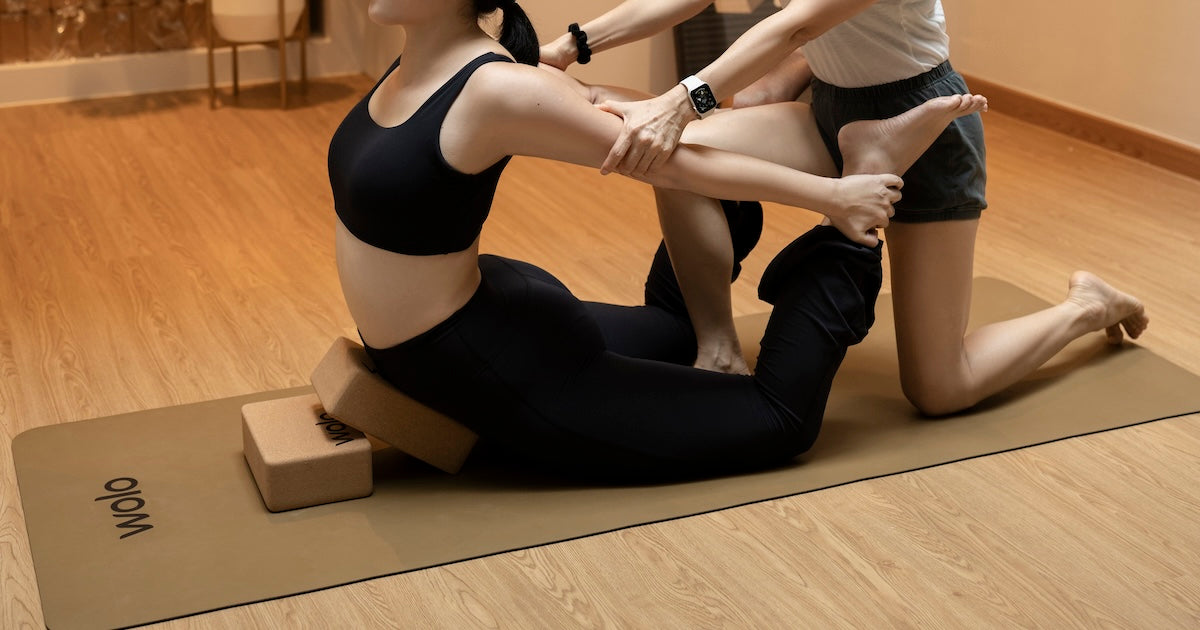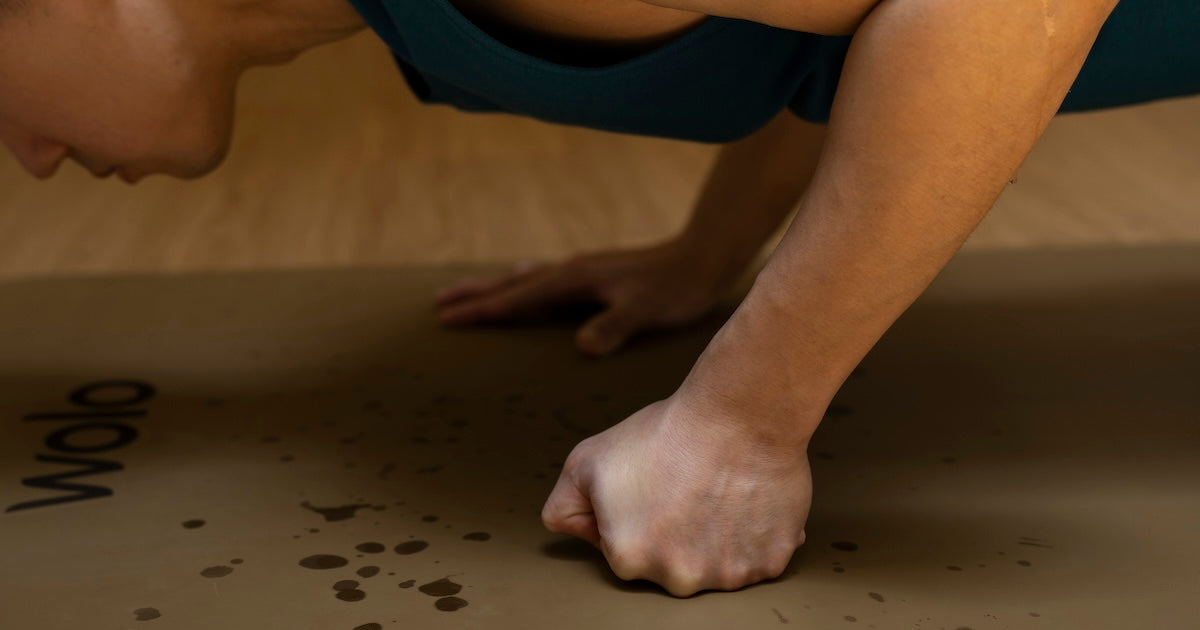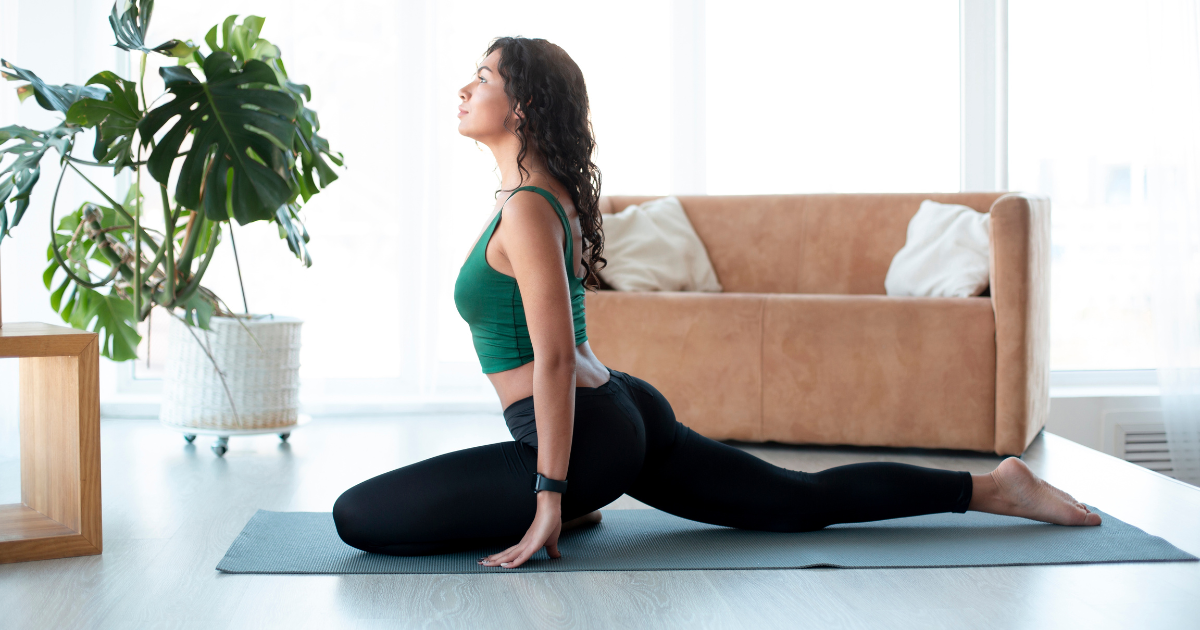Starting a yoga practice can feel like stepping into a new world, filled with possibilities for personal growth and physical improvement. It's a journey that begins with understanding the basic poses and principles, setting the foundation for a healthier you.
Yoga isn't just about bending and twisting; it's a holistic approach to uniting your body, mind, and spirit. Embracing the basics of yoga opens the door to improved well-being, offering a path to balance and inner peace that can transform your life.
Understanding what yoga is
Yoga is a comprehensive practice that combines physical postures, breathing exercises, and meditation. This ancient tradition aims to bring harmony between your body and mind, helping you achieve balance and tranquility.
Originating thousands of years ago, yoga has evolved into various styles and forms, each offering unique benefits. At its core, yoga encourages mindfulness and presents a way to live a more conscious and connected life, making it accessible to everyone, regardless of age or fitness level.
The multifaceted health benefits of yoga
Yoga offers a wide range of health benefits for both the body and mind. From enhancing flexibility and strength to reducing stress and improving mental clarity, its positive impacts are comprehensive, making it a powerful tool for overall well-being.

Improve flexibility and balance
Yoga gently stretches your muscles, increasing your range of motion and reducing stiffness. Regular practice leads to better flexibility, which, in turn, improves your balance. This makes daily activities easier and reduces your risk of falls as you age.
Enhance strength and muscle tone
Through various poses, yoga challenges your body in new ways, building muscle strength and enhancing tone. Poses like plank help strengthen the core, while others target different muscle groups, contributing to a well-rounded physical fitness routine.
Increase body awareness
Yoga encourages you to listen to your body and understand its needs. This heightened awareness can lead to better posture and movement in everyday life, helping you to avoid injuries and move more efficiently.
Alleviate and reduce stress
Practicing yoga introduces you to breathing exercises and meditation, both known for their stress-reducing properties. These practices help calm the mind, reduce anxiety, and promote emotional well-being, offering relief in a busy world.
Lose and maintain healthy weight
Yoga can be a valuable component of a weight management plan. By reducing stress, which is often linked to overeating, and providing physical activity that burns calories, yoga helps maintain a healthy weight and promotes a positive relationship with your body.
Prevent injuries
Yoga strengthens muscles and improves flexibility, which can help prevent injuries by ensuring your body can handle various stresses. Regular practice can also correct imbalances in the body, making you less prone to getting hurt during other physical activities.
Manage pain through mindful movements
Yoga's gentle movements and focus on alignment can alleviate pain, including chronic conditions like back pain. By increasing flexibility and strength, yoga offers a natural way to manage pain and improve quality of life.
Manage symptoms of chronic diseases
Yoga has been shown to help manage or improve symptoms of chronic diseases such as heart disease, high blood pressure, and diabetes. Its stress-reducing features and physical benefits make it an effective complementary therapy for overall health maintenance.
Foundational yoga poses for beginners
Mastering foundational yoga poses is the first step toward building a solid practice. These poses lay the groundwork for more advanced techniques, helping beginners gain confidence and experience the benefits of yoga from the start.
1. Starting with child's pose (Balasana)

Child's Pose is a gentle stretch that relaxes the body and calms the mind. It's a restful pose that beginners can use to start their practice, offering a moment of peace and introspection.
How to: Mastering the basics
To get into Child's Pose, kneel on your yoga mat with your toes together and knees hip-width apart. Lower your hips to your heels and stretch your arms forward on the mat, resting your forehead on the ground. Breathe deeply and let your body relax.
2. Transitioning into downward facing dog (Adho mukha svanasana)

Downward Facing Dog is a key pose that strengthens the entire body while stretching the back, shoulders, and legs. It's a foundational pose that prepares you for a wide range of other poses, making it essential for beginners to learn.
How to: Achieving the pose
Begin on all fours, with hands under shoulders and knees under hips. Spread fingers wide and press palms into the mat. As you exhale, lift your hips toward the ceiling, straightening your arms and legs. Aim for an inverted V shape with your body. Keep your heels down, and gently press your chest towards your thighs while letting your head hang freely between your arms. Take slow, deep breaths, and hold the pose for a few breath cycles. When you're ready, gently release and enjoy the rejuvenating stretch!
3. Exploring the low lunge (Anjaneyasana)

The Low Lunge, or Anjaneyasana, is a great starting point for beginners to open up their hips and enhance flexibility. This pose also helps in building mental focus as you balance and breathe. It stretches the thighs and groins while improving the mobility in your hip joints, making it a beneficial pose for those who sit a lot during the day.
How to: step-by-step
To get into a Low Lunge, start by standing at the top of your mat. Take a big step back with your right foot and lower your right knee to the floor, keeping your left knee directly above your left ankle. Raise your arms above your head, keeping them straight and your palms facing each other. Engage your core and lengthen your spine as you look straight ahead. Hold this pose for a few breaths, then switch legs and repeat. Remember to breathe deeply and maintain a steady focus.
4. Experiencing the cobra pose (Bhujangasana)

The Cobra Pose, or Bhujangasana, is a gentle backbend that strengthens the spine and opens the chest and lungs. This pose is perfect for beginners as it helps in reducing lower back stiffness and encourages the chest to open, promoting better breathing. It's a simple yet effective way to introduce movement in the spine for those who spend a lot of time sitting.
How to: Technique and benefits
To practice Cobra Pose, lie on your stomach with your hands under your shoulders and your fingers pointing forward. Press into your hands and slowly lift your chest off the floor, keeping your elbows close to your body. Only go as high as comfortable, ensuring your lower body remains relaxed. Hold for a couple of breaths, then gently lower yourself back down. This pose not only strengthens the back but also helps to relieve stress and fatigue by opening up the heart and lungs.
5. Building strength with chair pose (Utkatasana)

Chair Pose, or Utkatasana, is like sitting in an invisible chair. This powerful pose strengthens the thighs and ankles, while toning the shoulders, butt, hips, and back. It's an excellent pose for beginners to build strength and stamina. Additionally, it stimulates the heart and diaphragm, making it as beneficial for your cardiovascular health as it is for your muscles.
How to: Proper form and focus
To enter Chair Pose, stand with your feet slightly apart. Stretch your arms forward, parallel to the floor with palms facing down. Bend your knees and push your hips back as if you are sitting in a chair. Ensure your knees don't go beyond your toes. Keep your back straight and engage your core. Hold this position for a few breaths, then stand back up. Focus on keeping your weight in your heels and your spine long throughout the pose.
6. Stretching with extended side angle pose (Utthita parsvakonasana)

Extended Side Angle Pose, or Utthita Parsvakonasana, stretches the sides of your body, opens your lungs, and enhances stamina. It's a pose that challenges your balance and flexibility, but it's incredibly rewarding for beginners. This pose strengthens your legs while opening your chest and shoulders, promoting better posture and breathing.
How to: Execution and alignment
Start in a standing position and step your feet about 4 feet apart. Turn your right foot out 90 degrees and your left foot in slightly. Bend your right knee until it's directly over your right ankle. Extend your right arm and place it on the outside of your right foot. Stretch your left arm over your left ear, palm facing down. Look up towards your left hand. Hold this pose for a few breaths, then repeat on the other side. Focus on extending through both sides of your body equally.
7. Opening up with pigeon pose (Eka pada rajakapotasana)

Pigeon Pose, or Eka Pada Rajakapotasana, is a fantastic stretch for the hips, thighs, and glutes. It's particularly beneficial for people who lead sedentary lifestyles or athletes looking to improve flexibility. This pose can help alleviate lower back pain and stiffness. Pigeon Pose is also a great way to explore and release emotional tension in the hips.
How to: Finding comfort in the stretch
Begin on all fours. Bring your right knee forward and place it behind your right wrist. Extend your left leg back, keeping your hips square to the front of your mat. Lower your torso down for a deeper stretch, resting on your forearms or extending your arms in front of you. Hold the pose and breathe deeply, allowing your hips to open gently. Switch sides after a few breaths. Remember, it's important to go into this stretch gently and listen to your body, never forcing the pose.
8. Elevating with bridge pose (Setu bandha sarvangasana)

Bridge Pose, or Setu Bandha Sarvangasana, is a gentle inversion that strengthens the back, buttocks, and hamstrings while stretching the chest, neck, and spine. It's an accessible pose for beginners that can help alleviate stress and mild depression. The uplifting effect of Bridge Pose on your body and mood makes it a favorite among yoga practitioners.
How to: Lifting and lengthening
Lie on your back with your knees bent and feet flat on the floor, hip-width apart. Place your arms at your sides, palms down. Press your feet and arms into the floor as you lift your hips toward the ceiling. Keep your thighs and feet parallel as you clasp your hands under your back, extending through your arms to help lift your hips higher. Hold a few breaths, then release the clasp and slowly lower your spine to the floor. Focus on lifting with your chest and engaging your legs and buttocks to support the lift.
9. Balancing with tree pose (Vrksasana)

Tree Pose, or Vrksasana, is a balancing pose that promotes concentration, balance, and groundedness. This pose strengthens the thighs, calves, ankles, and spine while stretching the groins and inner thighs. For beginners, Tree Pose is an excellent way to improve focus and stability, both mentally and physically.
How to: Roots and reach
Begin by standing tall and shifting your weight onto your left foot. Place the sole of your right foot on your inner left thigh, calf, or ankle, avoiding the knee joint. Bring your palms together in front of your heart or raise your arms above your head, keeping them straight and palms facing each other. Gaze softly at a fixed point in front of you to help maintain balance. Hold for a few breaths, then switch sides. Remember, it's okay to sway a little—trees do, too!
10. Relaxing into corpse pose (Savasana)

Savasana, or Corpse Pose, is more than just lying on your back—it's a deep relaxation technique that marks the end of your yoga practice. This pose allows your body to absorb the benefits of your session, turning inward to find a state of calm. As you lay flat, with your arms and legs comfortably apart, your breath deepens, guiding you towards a meditative state. It's a moment dedicated entirely to physically and mentally letting go, which can be surprisingly challenging yet profoundly rejuvenating.
How to: Letting go
To truly embrace Savasana, start by lying on your back, legs slightly apart, and arms at your sides with palms facing up. Close your eyes and take a deep breath in, then slowly exhale, feeling your body sink into the ground. Focus on releasing tension from each part of your body, starting from your toes and moving up to your head. Allow your breath to be natural, and with each exhale, imagine letting go of any thoughts, stresses, and tension. Remain in this state of relaxation for 5 to 10 minutes, embracing the stillness and the sense of peace it brings.
Navigating different styles and classes
Starting yoga can feel like walking into a world with its own language. There are so many styles and classes, each offering a unique experience. Some are fast-paced and physically demanding, while others are gentle and focus more on relaxation. Understanding the differences can help you find a class that aligns with your needs and goals.
Whether you're looking to increase flexibility, build strength, or find peace of mind, there’s a yoga style for you. Exploring various classes can keep your practice exciting and help you discover what resonates most with your body and spirit.
Exploring the types of yoga suitable for beginners
For beginners, navigating the myriad of yoga styles can be daunting. Below are a few of our recommendations:
- Hatha yoga is a great starting point. It emphasizes physical postures and slow movements, making it easier to learn the basics.
- Although Vinyasa is a bit more dynamic, it synchronizes breath with movement, offering a smooth transition between poses that can be adjusted to your pace.
- Yin yoga is another excellent option. It focuses on passive stretches that are held for longer periods, improving flexibility and promoting relaxation.
These styles provide a solid foundation, allowing beginners to explore their practice safely and gradually build strength and confidence.
Steps to selecting the right class for you
Finding the right yoga class involves a bit of research and self-reflection.
First, identify your goals: Are you seeking to improve flexibility, reduce stress, or both? Next, consider the class level. If you're new to yoga, look for beginner or all-level classes that emphasize foundational poses and techniques. It’s also helpful to read class descriptions and teacher bios to get a sense of the class pace and focus.
Don’t hesitate to ask questions—most studios are happy to help match you with the perfect class. Lastly, try a few different styles and teachers to find what best suits your needs and preferences.
Essential tips for yoga beginners
Starting your yoga journey is exciting, but knowing where to begin can be overwhelming. Remember, yoga is about personal growth, not perfection. Below are a few tips to help you start your yoga journey on the right foot.
Preparing for your first yoga class
Before your first yoga class, ensure you're dressed comfortably in clothing that allows for a full range of motion. Arrive early to settle in and introduce yourself to the instructor, informing them of any injuries or concerns. Bring a water bottle, a towel, and, if possible, your own yoga mat for hygiene and comfort.
Start with an open mind and no expectations. Remember, it’s okay to take breaks and modify poses as needed. Your first class is an introduction to yoga's vast world, so focus on the experience and enjoy the journey.
Essential yoga gear for starters
All you need to begin your yoga practice is your body, your breath, and your willingness to learn. However, a few key items can enhance your experience.
A yoga mat is essential for providing cushioning and traction. Comfortable, stretchy clothing allows for unrestricted movement. While not necessary, yoga blocks and a strap can help with alignment and accessing poses. Lastly, a water bottle will keep you hydrated, and a small towel can help manage sweat. Remember, the goal is comfort and functionality, not fashion.
Common mistakes to avoid as a beginner
Many beginners make the mistake of comparing their journey to others. Focus on your own practice and listen to your body. Skipping the warm-up or pushing into painful poses can lead to injury, so always start gently and respect your limits. Neglecting breathwork is another common oversight; your breath is a powerful tool that helps deepen poses and enhance relaxation. Finally, inconsistency can hinder progress. Regular practice, even if it's just a few minutes a day, is key to experiencing the full benefits of yoga.
Incorporating meditation and mindfulness into your routine
Meditation and mindfulness are central aspects of yoga that extend beyond physical poses. Begin by setting aside a few minutes before or after your yoga practice for meditation, focusing on your breath or a mantra.

Mindfulness can also be integrated throughout your day—not just on the mat. Pay attention to your breath, thoughts, and the present moment during everyday activities. This practice can reduce stress, enhance focus, and contribute to a sense of peace and well-being. Remember, meditation is a skill that improves with practice, so be patient and persistent.
Embracing the journey: Patience and consistency
Yoga is a personal journey that unfolds over time. Progress may not always be linear, and that's okay. The key to a rewarding practice is patience and consistency. Celebrate small victories, like noticing improved flexibility or feeling more relaxed. Stay committed to your practice, as regularity is more important than duration. Even on days when motivation wanes, a short practice is better than none. Embracing yoga as a lifelong journey rather than a destination can transform your practice into a source of joy and discovery.
The path forward: Deepening your yoga practice
As you continue your yoga journey, exploring new poses and styles can deepen your practice and unlock new physical and mental strength levels.
Attending workshops or retreats, practicing with different teachers, and integrating yoga philosophy into your practice can also enrich your understanding. Stay curious and allow your practice to evolve organically. Remember, the deeper you go, the more profound the benefits, both on and off the mat.
Progressing from beginner to intermediate poses
Moving from beginner to intermediate yoga poses is an exciting step that requires patience, practice, and mindfulness. Focus on building a strong foundation with basic poses before attempting more complex asanas. Listen to your body and progress at your own pace, using props for support and alignment.
Consistent practice will naturally improve your strength, flexibility, and balance, preparing you for more advanced poses. Celebrate your progress, knowing that each step forward is a reflection of your dedication and hard work.
The importance of community and support in yoga
Yoga is not just a personal practice; it's also about community and connection. Engaging with a yoga community can provide encouragement, inspiration, and a sense of belonging.

Whether through classes, online forums, or local events, connecting with others who share your passion for yoga can enhance your practice and provide valuable support. Sharing experiences and challenges can also offer new perspectives and motivation. Remember, everyone's yoga journey is unique, but we can all grow together in a supportive community.
Finding inspiration and motivation through yoga stories
Every yogi has a story; hearing about others' journeys can be incredibly inspiring. From transformational tales of physical healing to profound experiences of mental and emotional growth, these stories remind us of yoga's transformative power.
Seeking out books, podcasts, and articles featuring yoga stories can motivate you to deepen your own practice. Additionally, sharing your journey can inspire others and reinforce your commitment to yoga. Let these stories remind you that anything is possible when you stay dedicated to your practice.
A transformative journey: Final thoughts on starting yoga
Embarking on your yoga journey is like opening a door to a new dimension of health and wellness. It's not just about touching your toes or standing on one leg; it's about breathing deeply, moving your body in sync with your breath, and finding peace within yourself. Remember, every yogi started as a beginner, and every pose was once new. So, give yourself the grace to be a beginner, to stumble, and to grow.
As you continue on this path, you'll discover that yoga is more than a workout; it's a lifestyle. With each pose, breath, and practice, you're not just transforming your body but your life. The strength and flexibility you develop on the mat are only a small part of the journey. The true magic of yoga lies in the clarity, calmness, and joy it brings into your everyday life. So, keep practicing, stay curious, and embrace the beautiful journey of yoga with an open heart and mind.





